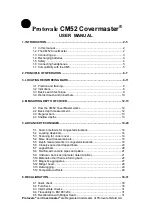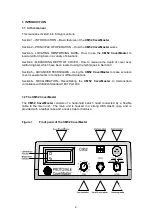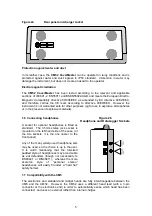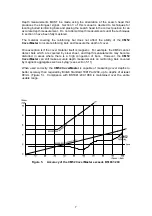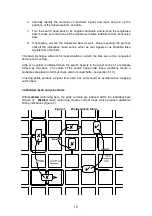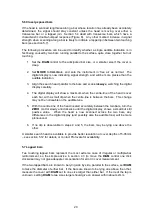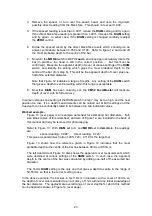
13
8. If an audible indication is not required, switch the
MODE
control back to DEPth.
CAUTION – Whenever possible, use the audible indication until you are
absolutely certain of the layout of the reinforcing bars. Having the audible
indication sounding does NOT significantly decrease operating hours.
4.3 Irregular bars
The
CM52 CoverMaster
is factory-calibrated for round ribbed high-tensile bars, and
correctly indicates the minimum depth of cover from the surface to the closest peaks of
the ribs. The depth of cover over smooth round bars will thus be slightly underestimated,
though this is rarely of practical importance (if it is, see section 6 on RECALIBRATION).
For some structures, an acceptable alternative to a single large reinforcing bar is a bundle
of smaller bars with the same total cross-sectional area – typically two, three or four bars.
The most common arrangement is two lapped bars – see section 5.7 for further details.
As a general rule, select the diameter of one bar, then move the
DIAM
control one click
clockwise for each extra bar in the bundle.
Square-section bars are occasionally found in older structures. For these bars, turn the
DIAM
control to the setting nearest to 1.1 times the width of a side. Sometimes a square
bar may be twisted so that its orientation varies continuously from flat to edge-on. Where
the bar is edge-on to the surface of the concrete, the minimum depth of cover will be
underestimated by 25% of the effective diameter which was set using the
DIAM
control.
Where the bar is lying flat beneath the surface of the concrete, the minimum depth of
cover will be overestimated by 11% of the effective diameter. As a general rule for twisted
square bars, set the
DIAM
control to the width of a side, or one larger. Then the cover
can generally be estimated within (–25, +11)% of the effective diameter chosen.
4.4 Shallow depths
If the indicated cover depth is less than about 27mm, the instrument warns you by
deliberately changing the display to ‘000
m
’ rather than lose accuracy. In such cases, you
may turn the search head over and use the white face. This adds exactly 30mm to the
depth below the search coils and restores full accuracy.
When using the white face, always remember to
subtract 30mm from the indicated
reading
. Do not use the white face unless it is necessary. If the cover is only just under
27mm, it will be more accurate to put a spacer of only 10mm between the concrete and
the black face of the head – see section 5.5 later.
Section 5.4 gives further information on resolving multiple shallow bars.
But for shallow cover, and especially if the bars are closely-spaced,
use the Midget Head
in preference to the white face of the standard head, as described later in section 5.12.
This completes the instructions for inexperienced users and normal situations. Sections 5
and 6 deal with advanced techniques for using the CM52 CoverMaster in more difficult or
specialised situations.


